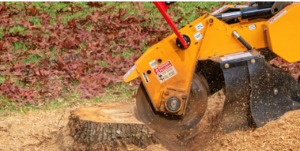Stumps are unsightly eyesores that attract pests and fungus. Plus, they occupy valuable yard space. But there are ways to get rid of them!
Renting a stump grinder may be costly and time-consuming. Other solutions, including burning and chemicals, may prove more suitable depending on the size and root system of the stump in question.
 Stump Grinder
Stump Grinder
A stump grinder is an efficient and cost-cutting machine used for grinding down old or unsightly tree stumps, saving tree removal companies time and effort. This powerful piece of equipment utilises a rotating blade that cuts roots while chewing down or grinding off top layers; wood chips created from this process can then be used as mulch or other landscaping needs.
BlackStumpTreeServices stump removal Adelaide Hills always conducts an assessment before using their stump grinder in an area to ensure it is safe. They check to see that there is the solid footing for their machine and there are no safety hazards present such as rocks, twigs or fences; additionally, they will observe any underground lines, such as water/gas pipes/sprinkle systems/metal fencing/roof shingles that might be present.
Once an operator is ready to start, they should position their machine over the stump and engage the power lever. Slowly lower the cutting wheel into the stump for a continuous pass as they assess for any hidden hazards such as cement or rebar that could obstruct its path; additionally, grinding roots first will prevent any significant damage to either machine or operator from becoming hidden under wood chips that accumulate over time.
Copper Sulfate
Copper sulphate is an effective stump remover and an efficient fungicide, algaecide and root killer. Available at most hardware and garden retailers, copper sulphate can also be found soluble in water, methanol and slightly in glycerol for use as a seed treatment or treating dormant tree fire blight.
Copper sulphate can be effectively utilised as a tree stump remover by driving copper nails into and into its base. This approach works by preventing water intake into the stump and ultimately killing it off; however, using copper nails may damage surrounding soil and vegetation and cause direct physical damage to its roots.
According to Purdue University Forestry Dept’s recommendation, another method is pouring copper sulphate solution into stump holes and packing it tightly with sticks or the end of hammers. This BlackStumpTreeServices stump removal Adelaide Hills solution directly targets the cambium layer, transporting nutrients and water.
Copper sulphate may take several months to work its magic on the stump, but this method is cost-effective. Along with copper sulphate, you will require a drill with 1/4 to 1-inch drill bits, a tarp, heavy rocks or stakes and some form of ground protection that can protect surrounding plants from accidental spillage of chemicals used on it.
Fire
Fire is one of the easiest, cheapest, and simplest ways of stump removal. Not only is Stump Burning effective and affordable, but it is also simple. However, before trying any form of open burning, please check with your local fire department first for regulations pertaining to open burns; clear away all flammable materials from around your stump as well.
This method of stump removal is best suited for older, dry stumps that have been in the ground for some time. Chemical accelerants such as potassium nitrate can help the fire spread deeper into the stump and roots to expedite up to four times faster decomposition.
A drill that can bore into wood easily is required to use this technique effectively, along with a funnel, boiling water, saltpetre or potassium nitrate powder, and some boiling water. After drilling holes in the top of your stump, pour in both substances at once; allow time for absorption before pouring diesel or kerosene and setting the fire.
The fire must always be watched closely to avoid its spread. Be sure to have water close at hand or nearby with you so as not to spread further. This process may take anywhere from 12 hours to several days, depending on its size and how well it burns away.